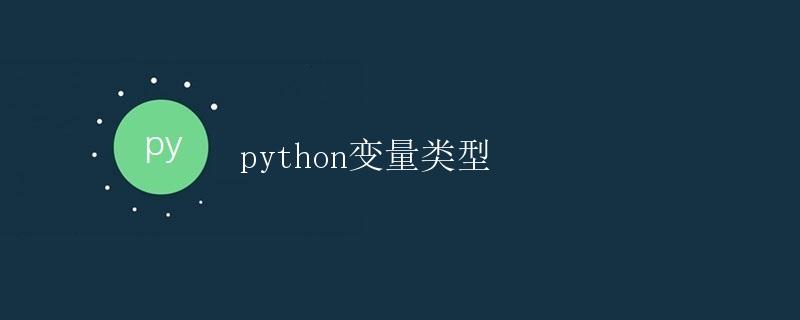Python变量类型

1. 变量和数据类型
在编程语言中,变量是存储和表示数据的一种方式。每个变量都有一个名称和一个对应的值。Python是一种动态类型的编程语言,变量的类型是根据赋予的值自动推导出来的。这意味着,你可以在同一个变量中存储不同类型的数据,而无需事先声明变量的类型。
Python中的数据类型包括如下几种:
- 数字 (Number):整数、浮点数、复数
- 字符串 (String):由字符组成的文本
- 列表 (List):有序、可变的数据集合
- 元组 (Tuple):有序、不可变的数据集合
- 集合 (Set):无序、无重复元素的数据集合
- 字典 (Dictionary):无序的键值对集合
在进行变量定义时,可以直接赋值给变量,Python会自动识别变量中存储的数据类型。例如:
x = 5 # 整数类型
y = 3.14 # 浮点数类型
z = "Hello" # 字符串类型
2. 数字类型
Python中的数字类型包括整数、浮点数和复数。其中,整数是没有小数部分的数字,如1、100等。浮点数是带有小数部分的数字,如3.14、2.718等。复数由实部和虚部组成,形式为a + bj,其中a和b分别为实部和虚部的数字。Python中的数字类型支持各种算术运算,例如加法、减法、乘法和除法。示例代码如下:
a = 5
b = 3.14
c = 2 + 3j
# 加法
print(a + b) # 输出: 8.14
print(b + c) # 输出: (5.14 + 3j)
# 减法
print(a - b) # 输出: 1.86
print(b - c) # 输出: (-0.86 + 3j)
# 乘法
print(a * b) # 输出: 15.7
print(b * c) # 输出: (6.28 + 9.42j)
# 除法
print(a / b) # 输出: 1.592356687898089
print(b / c) # 输出: (0.4926108374384236 - 0.2254335260115607j)
3. 字符串类型
字符串是由字符组成的文本类型。在Python中,字符串可以使用单引号或双引号来表示。示例代码如下:
a = 'Hello'
b = "World"
# 字符串拼接
c = a + b
print(c) # 输出: HelloWorld
# 字符串长度
print(len(c)) # 输出: 10
# 字符串索引
print(c[0]) # 输出: H
print(c[6]) # 输出: W
# 字符串切片
print(c[1:5]) # 输出: ello
print(c[:5]) # 输出: Hello
print(c[6:]) # 输出: World
# 字符串格式化
age = 20
name = "Alice"
print("My name is %s and I'm %d years old." % (name, age))
# 输出: My name is Alice and I'm 20 years old.
# 字符串方法
s = "Hello, World!"
print(s.lower()) # 输出: hello, world!
print(s.upper()) # 输出: HELLO, WORLD!
print(s.replace("Hello", "Hi")) # 输出: Hi, World!
4. 列表类型
列表是有序且可变的数据集合,可以存储不同类型的元素。列表中的每个元素都有一个对应的索引,第一个元素的索引为0。列表可以通过方括号[]来声明,多个元素之间使用逗号分隔。示例代码如下:
fruits = ["apple", "banana", "orange"]
numbers = [1, 2, 3, 4, 5]
mixed = [1, "apple", 3.14, True]
# 访问列表元素
print(fruits[0]) # 输出: apple
print(numbers[2]) # 输出: 3
print(mixed[1]) # 输出: apple
# 更新列表元素
fruits[1] = "grape"
print(fruits) # 输出: ['apple', 'grape', 'orange']
# 列表长度
print(len(fruits)) # 输出: 3
# 列表方法
fruits.append("kiwi")
print(fruits) # 输出: ['apple', 'grape', 'orange', 'kiwi']
fruits.remove("grape")
print(fruits) # 输出: ['apple', 'orange', 'kiwi']
numbers.sort()
print(numbers) # 输出: [1, 2, 3, 4, 5]
5. 元组类型
元组是有序且不可变的数据集合,可以存储不同类型的元素。与列表不同,元组的元素不能被修改。元组可以通过圆括号()来声明,多个元素之间使用逗号分隔。示例代码如下:
fruits = ("apple", "banana", "orange")
numbers = (1, 2, 3, 4)
# 访问元组元素
print(fruits[0]) # 输出: apple
print(numbers[2]) # 输出: 3
# 元组长度
print(len(fruits)) # 输出: 3
# 元组切片
print(fruits[:2]) # 输出: ('apple', 'banana')
6. 集合类型
集合是无序且无重复元素的数据集合,用于进行集合运算,比如并集、交集和差集等。集合可以通过花括号{}或set()函数来声明,多个元素之间使用逗号分隔。示例代码如下:
fruits = {"apple", "banana", "orange"}
# 访问集合元素(由于集合是无序的,无法通过索引访问,只能遍历)
for fruit in fruits:
print(fruit) # 输出: apple banana orange
# 添加元素
fruits.add("kiwi")
print(fruits) # 输出: {'apple', 'kiwi', 'banana', 'orange'}
# 删除元素
fruits.remove("banana")
print(fruits) # 输出: {'apple', 'kiwi', 'orange'}
7. 字典类型
字典是无序的键值对集合,可以存储不同类型的值。每个键值对之间使用冒号:分隔,键值对之间使用逗号分隔。字典可以通过花括号{}或dict()函数来声明。示例代码如下:
student = {
"name": "Alice",
"age": 20,
"major": "Computer Science"
}
# 访问字典值
print(student["name"]) # 输出: Alice
print(student["age"]) # 输出: 20
# 更新字典值
student["age"] = 21
print(student) # 输出: {'name': 'Alice', 'age': 21, 'major': 'Computer Science'}
# 字典长度
print(len(student)) # 输出: 3
# 字典方法
student["grade"] = "A"
print(student) # 输出: {'name': 'Alice', 'age': 21, 'major': 'Computer Science', 'grade': 'A'}
student.pop("major")
print(student) # 输出: {'name': 'Alice', 'age': 21, 'grade': 'A'}
8. 类型转换
在Python中,可以使用内置函数将一个类型转换为另一个类型。常用的类型转换函数有int()、float()、str()、list()和dict()等。示例代码如下:
x = 5
y = "10"
z = [1, 2, 3]
# 转换为整数
print(int(y)) # 输出: 10
# 转换为浮点数
print(float(x)) # 输出: 5.0
# 转换为字符串
print(str(x)) # 输出: '5'
# 转换为列表
print(list(z)) # 输出: [1, 2, 3]
# 转换为字典
print(dict(name="Alice", age=20)) # 输出: {'name': 'Alice', 'age': 20}
9. 变量的命名规则
在Python中,变量的命名需要遵循一定的规则:
- 变量名由字母、数字和下划线组成,不能以数字开头。
- 变量名区分大小写,例如
age和Age是不同的变量。 - 不要使用Python关键字作为变量名,例如
print、for等。 - 变量名应该具有描述性,能够清楚地表达变量所代表的含义。
示例代码如下:
my_variable = 10
yourVariable = 20
_myVariable = 30
myVariable123 = 40
结论
本文介绍了Python中的各种变量类型,包括数字、字符串、列表、元组、集合和字典。通过示例代码和运行结果,我们可以更好地理解和应用这些数据类型。此外,还介绍了类型转换和变量命名规则等相关知识。
 极客教程
极客教程